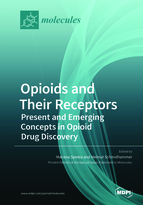Opioids and Their Receptors: Present and Emerging Concepts in Opioid Drug Discovery
A special issue of Molecules (ISSN 1420-3049). This special issue belongs to the section "Medicinal Chemistry".
Deadline for manuscript submissions: closed (31 July 2020) | Viewed by 82838
Special Issue Editors
Interests: opioid receptors; opioid pharmacology; pain research; CNS disorders; opioid drug discovery; structure-activity-relationships; GPCRs signalling
Special Issues, Collections and Topics in MDPI journals
Interests: medicinal chemistry; drug design; lead optimization; synthesis and analytics; synthetical methods; opioid drug discovery; structure–activity relationships; analgesics
Special Issue Information
Dear Colleagues,
The interest in opioid drugs such as morphine, the oldest analgesic drug known, has been maintained through the years. Identification of endogenous opioid peptides and their receptors (mu, delta, kappa, and nociceptin receptors), molecular cloning and elucidation of crystal structures of opioid receptors represent key milestones in opioid research. Activation of opioid receptors regulates several pharmacological responses with beneficial therapeutic as well as nonbeneficial effects. Medical use and misuse of opioids have strongly increased in the past decades, resulting in an opioid epidemic. Diverse chemical and pharmacological approaches have been used over the years to mitigate the deleterious effects of opioids.
This Special Issue aims to highlight present efforts in medicinal chemistry and pharmacology of innovative ligands targeting the opioid receptors as effective and safe therapeutics for human diseases where the opioid system plays a central role. Further, it wants to draw a special attention on advancing concepts in opioid drug discovery.
Central directions in opioid research include structure–activity/function relationships, biochemistry of the receptors, understanding of opioid receptor-mediated actions and the linkage between therapeutic effects, side effects and molecular mode of action, and new therapeutic opportunities and novel tools/technologies. The topics of this Special Issue cover drug design, molecular modeling and synthesis, structure–activity relationships on ligands with distinct properties (agonists, antagonists, partial agonists, biased agonists, allosteric modulators and ligands acting at multiple opioid receptors) or selective site of action (central, peripheral), drug screening, opioid pharmacology, pain research, animal models of diseases, and any other topics related to the field of opioid research.
This Special Issue welcomes original articles, short communications and review articles on recent advances and emerging concepts in opioid drug discovery and in general opioid research.
Prof. Dr. Mariana Spetea
Prof. Dr. Helmut Schmidhammer
Guest Editors
Manuscript Submission Information
Manuscripts should be submitted online at www.mdpi.com by registering and logging in to this website. Once you are registered, click here to go to the submission form. Manuscripts can be submitted until the deadline. All submissions that pass pre-check are peer-reviewed. Accepted papers will be published continuously in the journal (as soon as accepted) and will be listed together on the special issue website. Research articles, review articles as well as short communications are invited. For planned papers, a title and short abstract (about 100 words) can be sent to the Editorial Office for announcement on this website.
Submitted manuscripts should not have been published previously, nor be under consideration for publication elsewhere (except conference proceedings papers). All manuscripts are thoroughly refereed through a single-blind peer-review process. A guide for authors and other relevant information for submission of manuscripts is available on the Instructions for Authors page. Molecules is an international peer-reviewed open access semimonthly journal published by MDPI.
Please visit the Instructions for Authors page before submitting a manuscript. The Article Processing Charge (APC) for publication in this open access journal is 2700 CHF (Swiss Francs). Submitted papers should be well formatted and use good English. Authors may use MDPI's English editing service prior to publication or during author revisions.
Keywords
• Opioid receptors
• Pain
• CNS disorders
• Natural and synthetic compounds
• Small molecules and peptides
• Agonists, antagonists, and partial agonists
• Biased agonists and allosteric modulators
• Bi- and multifunctional ligands
• Drug design
• Computer-aided drug design
• Synthesis and analytics
• Pharmacophore modeling and dynamics simulations
• Structure–activity relationships
• Pharmacodynamics and pharmacokinetics
• Pharmacology
• Signal transduction








